Still Life Paintings
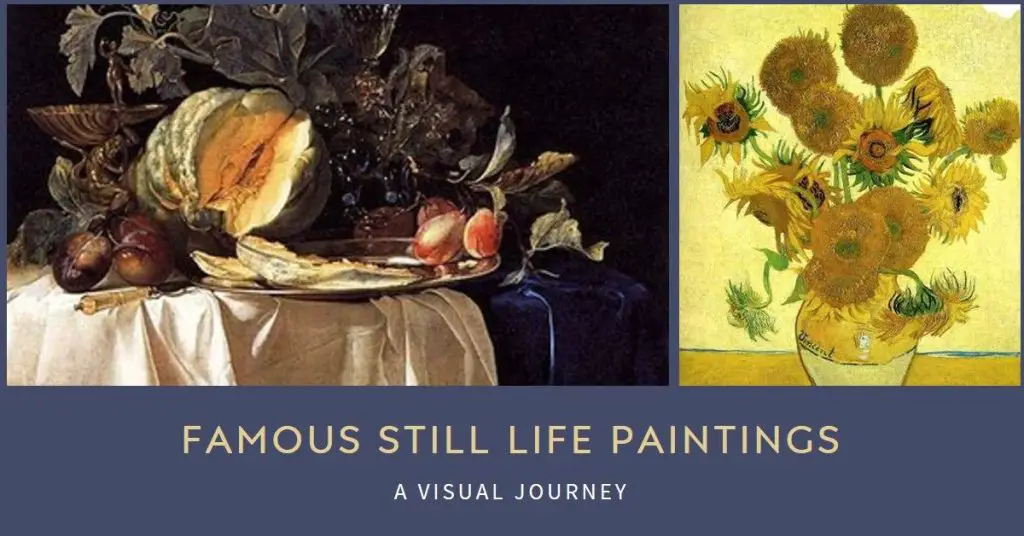
When we think of art, the first thing that comes to mind is usually a beautiful portrait or landscape painting. But what about still-life paintings?
These works of art often go unnoticed and are rarely discussed, yet they can be just as stunning and captivating as any other form of visual expression.
In this article, we will uncover 9 of history’s most famous still life paintings – from masterpieces by Dutch Baroque painters to contemporary pieces created in the 21st century.
Each piece tells a story – whether it’s capturing a moment in time or conveying an emotion – providing us with insight into our past while inspiring us creatively today.
So come join me on this journey through history as we explore 9 remarkable still-life paintings!
- Famous Still Life Paintings
- Overview Of Historical Still Life Paintings
- 1. Basket Of Fruit
- 2. Still Life with Cheeses, Almonds and Pretzels
- 3. Vanitas Still Life with Self-Portrait
- 4. Curtain, Jug and Fruitbowl
- 5. Wood Tankard and Metal Pitcher
- 6. Sunflowers (Third Version)
- 7. Violin and Candlestick
- 8. Still Life with Palette
- 9. Untitled (Still Life)
- 9. Still Life with Bananas
- How To Appreciate A Still-Life Painting?
- Final Thoughts on Famous Still Life Paintings
Overview Of Historical Still Life Paintings
Stories about famous still-life paintings are as timeless and captivating as the artworks themselves.
From Vincent van Gogh’s vibrant sunflowers to Jacob Van Es’ seductive basket of fruit, these works invite us into a world that transcends time and place.
Still-life painting has been an integral part of art history for centuries, providing audiences with glimpses of beauty in ordinary everyday objects while also revealing something profound about the human experience.
Despite its name, still life painting is anything but static. Through skilful use of colour, light and shadow, talented still life artists have crafted remarkable pieces that convey emotion and meaning beyond what can be seen on the surface.
The stories behind these works often tell tales of tragedy or triumph, conveying messages both universal and personal to viewers around the globe.
As we uncover eleven of history’s most famous still life paintings, let us explore how each one holds up a mirror to our collective humanity.
1. Basket Of Fruit
Jacob Van Es
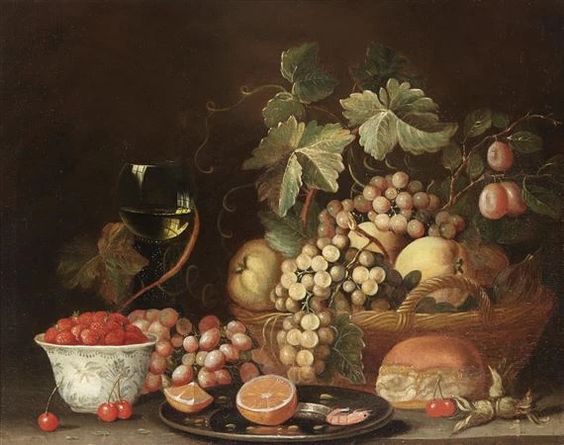
Jacob van Es is a renowned Dutch still life artist, best known for his oil painting of Basket of Fruit from 1625.
This work of art has long been admired by both scholars and enthusiasts alike as one of the most exemplary still lifes to emerge out of the 17th-century European tradition.
Van Es’ remarkable attention to detail in this piece is truly extraordinary: each individual fruit looks so alive that it appears almost edible!
From luscious grapes to juicy oranges, Van Es captures every aspect with such precision that one can’t help but be amazed at how he was able to achieve these results without photography or other modern imaging techniques.
Furthermore, his use of vibrant colours adds an extra layer of depth to the composition, making Basket of Fruit come alive before our eyes.
There’s no doubt that Jacob van Es set himself apart as a masterful still-life artist through this iconic painting.
His ability to capture nature in its finest details while also conveying a sense of grandeur and beauty makes him an important figure in the history of art.
As we move on to explore Adriaen van der Spelt’s Still Life With Fruits in Porcelain, it’s easy to see why Van Es will always remain one of the most celebrated painters within the genre.
2. Still Life with Cheeses, Almonds and Pretzels
by Clara Peeters
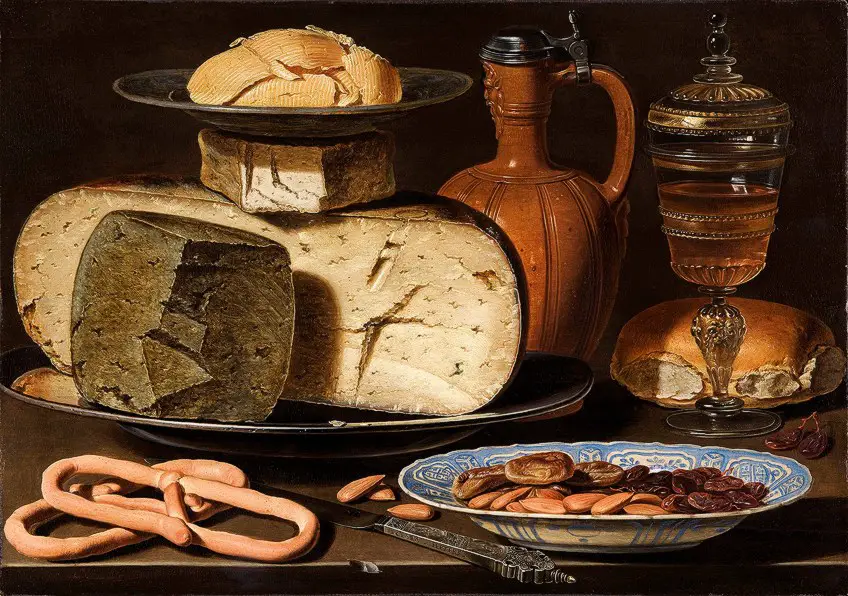
Still Life with Cheeses, Almonds and Pretzels (c. 1615) by Clara Peeters is an oil painting on a copper plate depicting a banquet spread of cheese, almonds, and pretzels.
This painting is a classic example of the Dutch Golden Age of painting and Peeters’ early still-life work. It is composed of a realistic array of foodstuffs on a table, painted with attention to detail and a naturalistic colour palette.
Cheese and pretzels are arranged artfully, with a variety of shapes and textures, and the almonds are presented in a neat pile.
3. Vanitas Still Life with Self-Portrait
by Pieter Claesz
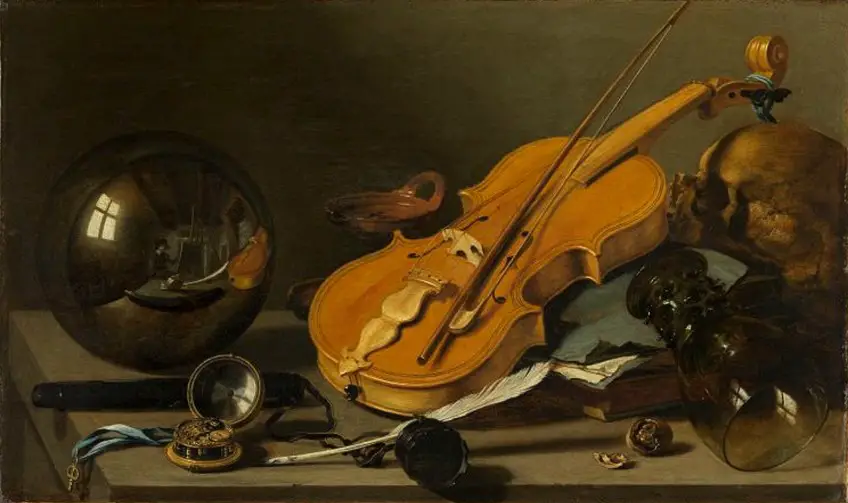
Pieter Claesz’s Vanitas Still Life with Self-Portrait (c. 1628) is a classic example of a vanitas painting.
The painting is a still-life arrangement of objects representing mortality and the vanity of earthly pursuits, including a skull, a candle, a pocket watch, a book, coins, and a quill.
The skull in the painting’s right is a memento mori, a reminder of death and the fleeting nature of life.
The muted colour scheme and soft lighting create a timeless and solemn atmosphere.
4. Curtain, Jug and Fruitbowl
by Paul Cézanne
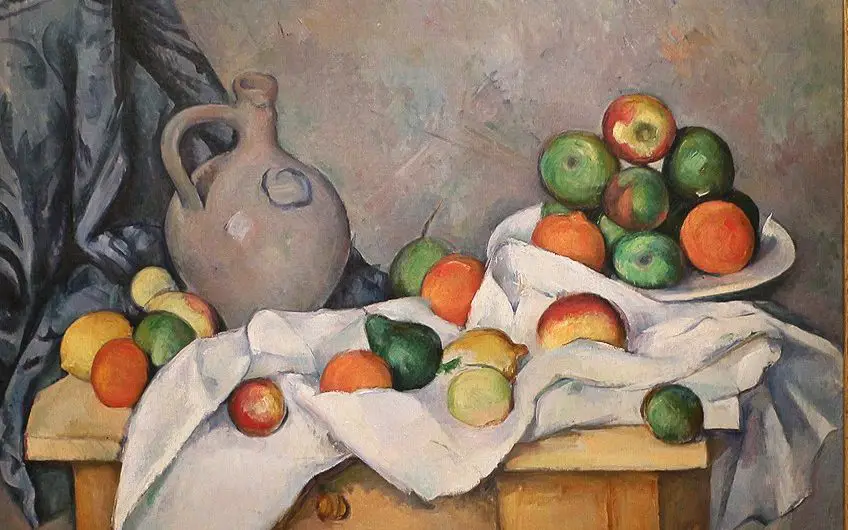
The still life painting Curtain, Jug and Fruitbowl (1893-1894) by Paul Cézanne is a visually captivating piece of artwork.
It consists of a white cloth curtain draped over a wooden table, a jug and brightly-coloured fruits such as pears and apples organised to create a pleasing composition.
This is a very typical style of Cézanne’s in which he combines a variety of objects within a single composition to create a harmonious balance.
The colours throughout the painting are vibrant and alive, with the reds and greens of the fruit bowl contrasting with the cool and muted tones of the fabric.
The jug, with its simple design, acts as a balancing point in the painting and creates a sense of unity in the composition.
The painting is also very symbolic in its nature, the white and blue fabrics can be seen as representing a barrier between the everyday world and the world of imagination, while the jug and fruit bowl symbolize abundance and knowledge.
All in all, Curtain, Jug and Fruitbowl (1893-1894) is a visually stunning painting that captures the beauty of everyday objects, and the unique vision of Paul Cézanne.
5. Wood Tankard and Metal Pitcher
by Paul Gauguin
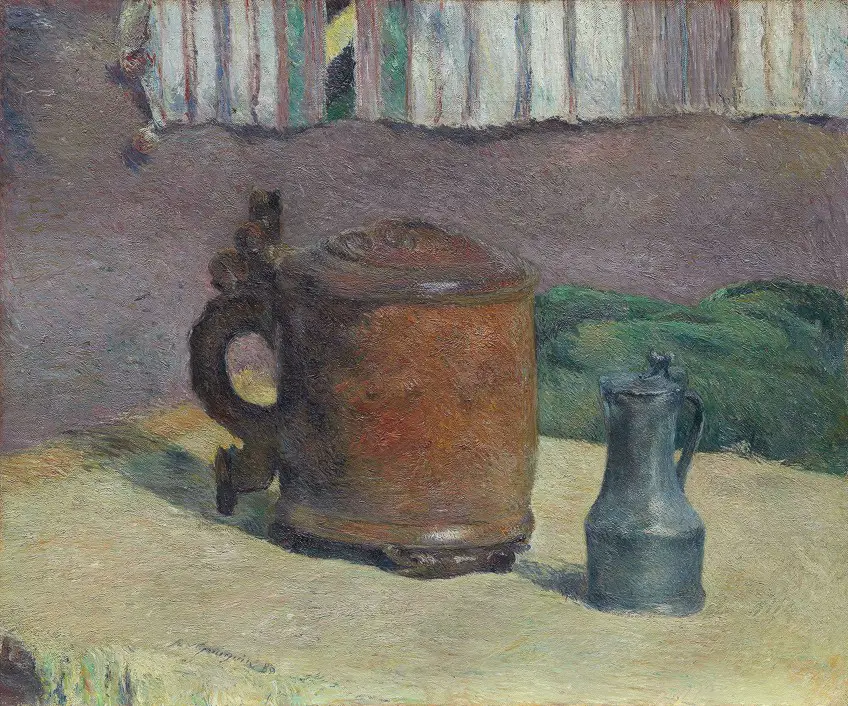
Wood Tankard and Metal Pitcher (1880) by Paul Gauguin is an oil on canvas still life painting. The painting shows a wooden tankard and a metal pitcher placed on a table before a pale blue wall.
The tankard is a simple, handmade vessel with a circular base and a long cylindrical body. Its wooden surface is covered in warm, brown tones, and the top of the tankard is decorated with a simple line design.
The metal pitcher has a bulbous body with a curved handle and a spout. Its silver and grey surface is highly reflective, giving the painting a sense of light and dimension. The wall behind the table is painted a pale purplish hue, giving the painting a cool, calming atmosphere.
Gauguin has used a limited colour palette, focusing on the warmth of the table surface and the cool hues of the objects, and using light and shadow to create a sense of depth.
The stillness of the table and wall, combined with the objects’ simple shapes, create a feeling of harmony and tranquillity.
Wood Tankard and Metal Pitcher (1880) is a beautiful example of Paul Gauguin’s still life painting style, which combines naturalistic elements with a strong sense of composition and colour.
6. Sunflowers (Third Version)
by Vincent van Gogh
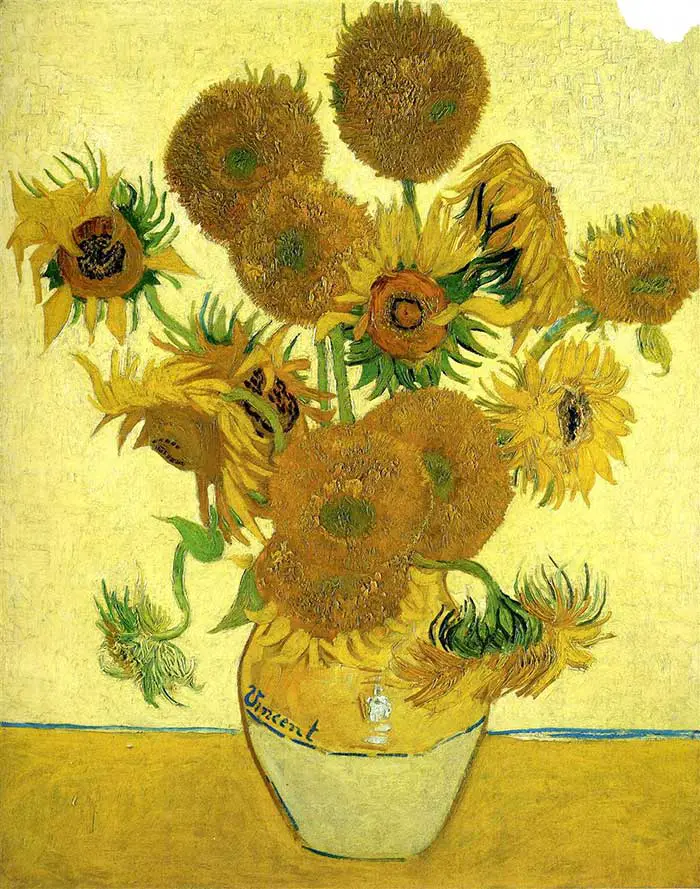
Sunflowers (Third Version) is an 1888 painting by Vincent van Gogh. It is a still-life painting in oil on canvas of a bouquet of sunflowers in a vase.
Warm colours such as yellow, orange, and red are used to depict the flowers. The painting also has a vibrant light yellow background.
The painting is considered to be one of van Gogh’s most famous works. Sunflowers have been interpreted as a symbol of life and death, as well as the natural cycle.
The sunflowers in the painting are all in various stages of development, with some in full bloom, others just starting to bloom, and some wilting.
The colours of the flowers contrast with the bright background, suggesting that life and death are intertwined.
The painting also exemplifies van Gogh’s signature painting style. His brushstrokes are visible in the painting, and the vase and flower lines are not perfectly straight.
This could be interpreted as a symbol of van Gogh’s passionate and emotional approach to painting.
Sunflowers (Third Version) is a beautiful and meaningful painting that demonstrates Van Gogh’s artistic abilities and his distinct style.
It’s vibrant colours and visible brushstrokes depict life and death, as well as the natural cycle.
7. Violin and Candlestick
by Georges Braque
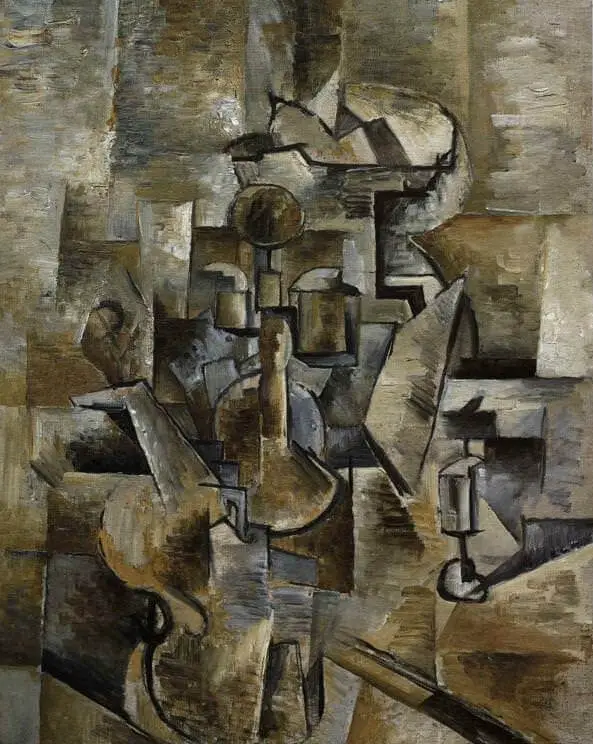
Georges Braque, a French artist, painted a still life in 1910 titled Violin and Candlestick. The violin is depicted in the typical cubist fragmented style.
The composition of the artwork is abstract, and Braque uses geometric patterns and shapes. He contrasts the light and dark parts of the picture using lines and forms to provide the illusion of depth and perspective.
The artwork is both peaceful and enthralling due to Braque’s use of color, form, and line to create an environment of introspection and quietness.
8. Still Life with Palette
by Roy Lichtenstein
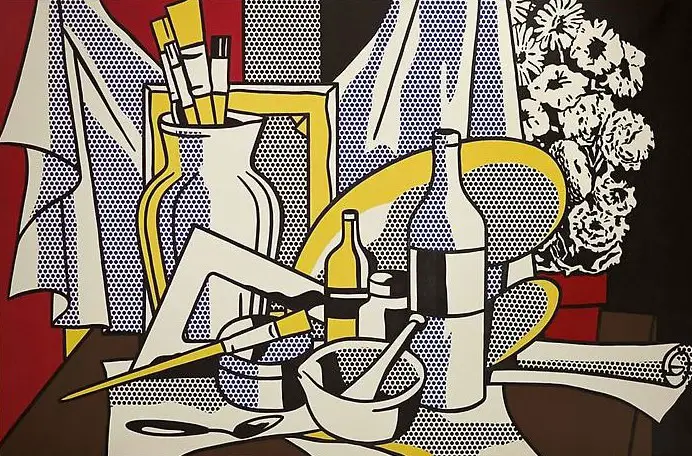
Roy Lichtenstein’s Still Life with Palette (1972) is a vibrant, colourful painting that displays a wide variety of objects in a still-life composition.
The painting has a very graphical finish, displaying different objects. The centre of the painting holds a palette with a variety of different paintbrushes in a vase to the left of the composition.
A draped fabric dominates the background with a bouquet of flowers on the right creating a sense of symmetry.
The various objects in the painting are rendered in Lichtenstein’s signature “pop art” style, with bold outlines, bright colours, and a comic book-like feel.
The flat, two-dimensional nature of the painting gives it a playful, cartoonish quality.
The artist also uses contour lines effectively in the painting, which helps to create a sense of depth and dimension.
The artist’s use of a limited colour palette throughout the painting creates a bright and cheerful atmosphere.
The composition of Still Life with Palette is carefully organized, with each object placed in a specific order and location.
The palette is the focal point of the painting, and everything else in the painting seems to be arranged around it.
This helps to give the painting a sense of balance and symmetry. Lichtenstein also uses a variety of shapes and forms throughout the painting, including circles, rectangles, and triangles, to create a cohesive and harmonious composition.
Overall, Roy Lichtenstein’s Still Life with Palette is a dynamic painting that combines Lichtenstein’s signature “pop art” style with a carefully organized composition.
9. Untitled (Still Life)
by Luc Tuymans
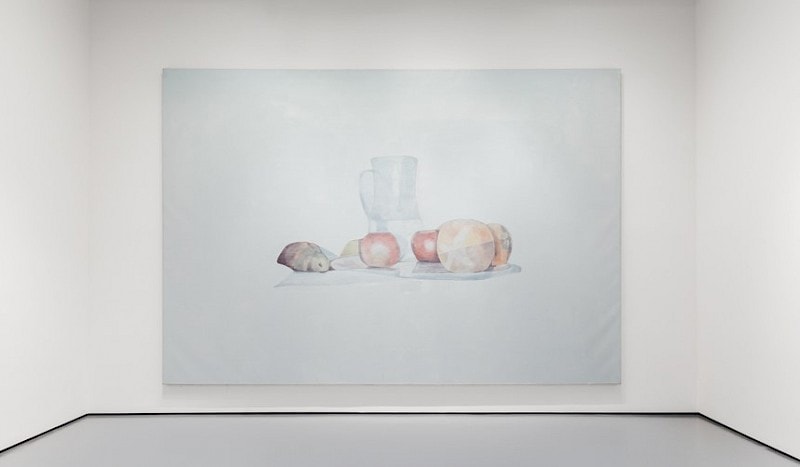
Untitled (Still Life), an oil painting by Luc Tuymans from 2002, is an engrossing examination of the conventional still life genre.
A lemon, an apple, a pear, a plate, and a glass are among the objects arrayed on a plain white tablecloth in the picture.
Due to the artist’s distinctive style, which combines a surrealist feeling of dreamy abstraction with a realistic approach to representation, this composition’s apparent simplicity is given a special level of intrigue.
The majority of the still life’s elements are depicted in a dreary, greyish-muted grey colour that dominates the painting’s restrained colour scheme.
As a result, there is a general feeling of melancholy and emptiness, which is accentuated by the empty white space around the objects.
The painting’s sole source of colour is the fruits that are a part of the composition.
This adds emphasis on the fruits which can be seen as a representation of vitality, life, and energy in a setting that appears to be barren and lifeless.
The fuzzy, surreal appearance of Tuymans’ paintings serves to emphasize this even more.
The lack of specificity in each component shows that the artist is more concerned with the overall mood of the composition than with any one specific object.
Untitled (Still Life) is an impressive examination of the conventional still life genre as a whole.
The objects’ seemingly random arrangement highlights the painting’s ethereal dreaminess even more.
This results in a composition that is both intriguing and thought-provoking and speaks to the elegance of the still life style.
9. Still Life with Bananas
by Fernando Botero
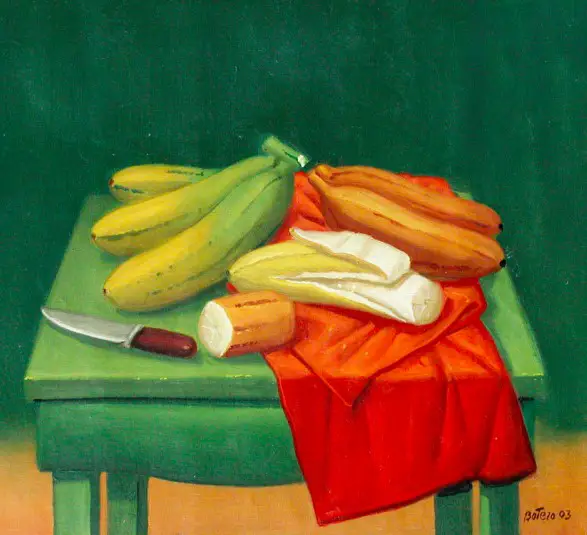
Fernando Botero’s Still Life with Bananas is a 2003 oil on canvas painting that captures the beauty of a seemingly mundane subject.
The composition of the painting is immediately striking, as Botero places the bananas in the centre of a square canvas, creating a focal point around which the other elements of the painting revolve.
The bananas are rendered realistically with vibrant colours and emphasise the shape of each banana.
The background of the painting is a simple green, which complements the red fabric on the table while allowing the bananas to stand out even more.
The other elements of the painting are rendered in a much more subtle manner.
The tabletop in a lighter value of green, while the knife to the left foreground of the painting adds some visual balance.
The coolness of the green on the table provides a nice contrast to the warm bright yellow and orange of some of the bananas.
How To Appreciate A Still-Life Painting?
Here are some pointers to aid you in appreciating these classic pieces of art.
- Spend some time first studying the painting. Note the composition, the placement of the elements, and the colour scheme.
- Pay close attention to the small details, such as the items’ textures, how the light affects them, and the shadows they cast. These particulars are frequently disregarded, but they can contribute to a painting’s aesthetic appeal.
- Taking into account the painter’s intention is another approach to assessing a still-life painting.
- What did they want to say? Was there a happy message, a sad message, or something else?
- You can better understand a painting’s significance and experience it emotionally by taking into account its intended audience.
- Finally, think about the painting’s symbolism. The objects shown, the colours utilized, and even the arrangement of the objects all serve as symbols.
- You can understand the painter’s intentions and feelings by analyzing the painting’s symbolism. Understanding the painting’s symbolism might also help you appreciate it on a more cerebral level.
It’s not always simple to enjoy a still-life painting, but by taking the time to consider its subtleties, symbolism, and meaning, you can better comprehend the picture and its beauty.
Take some time to examine and appreciate the beauty of the artwork the next time you find yourself in front of a still-life scene.
Final Thoughts on Famous Still Life Paintings
In conclusion, it is clear that famous still life paintings have had a significant impact on art throughout history.
From the intricate details of Jacob Van Es’ Basket of Fruit to the vibrant colours of Vincent Van Gogh’s Sunflowers, these paintings offer us a glimpse into the minds and talents of some of the greatest artists in history.
Appreciating them can be likened to unearthing hidden gems, with each canvas holding its own unique beauty and emotion.
It is interesting to note how much this genre has evolved over time. We have seen the shift from trompe l’oeil works to more abstract pieces filled with symbolism – all testament to the skill and creativity of those who created them.
The popularity of still life painting continues to grow today; it serves as an important reminder that while technology evolves at breakneck speed, art remains timeless.
It also reinforces my belief that art should not be merely admired but experienced – like taking a journey through different periods in history and uncovering stories along the way.
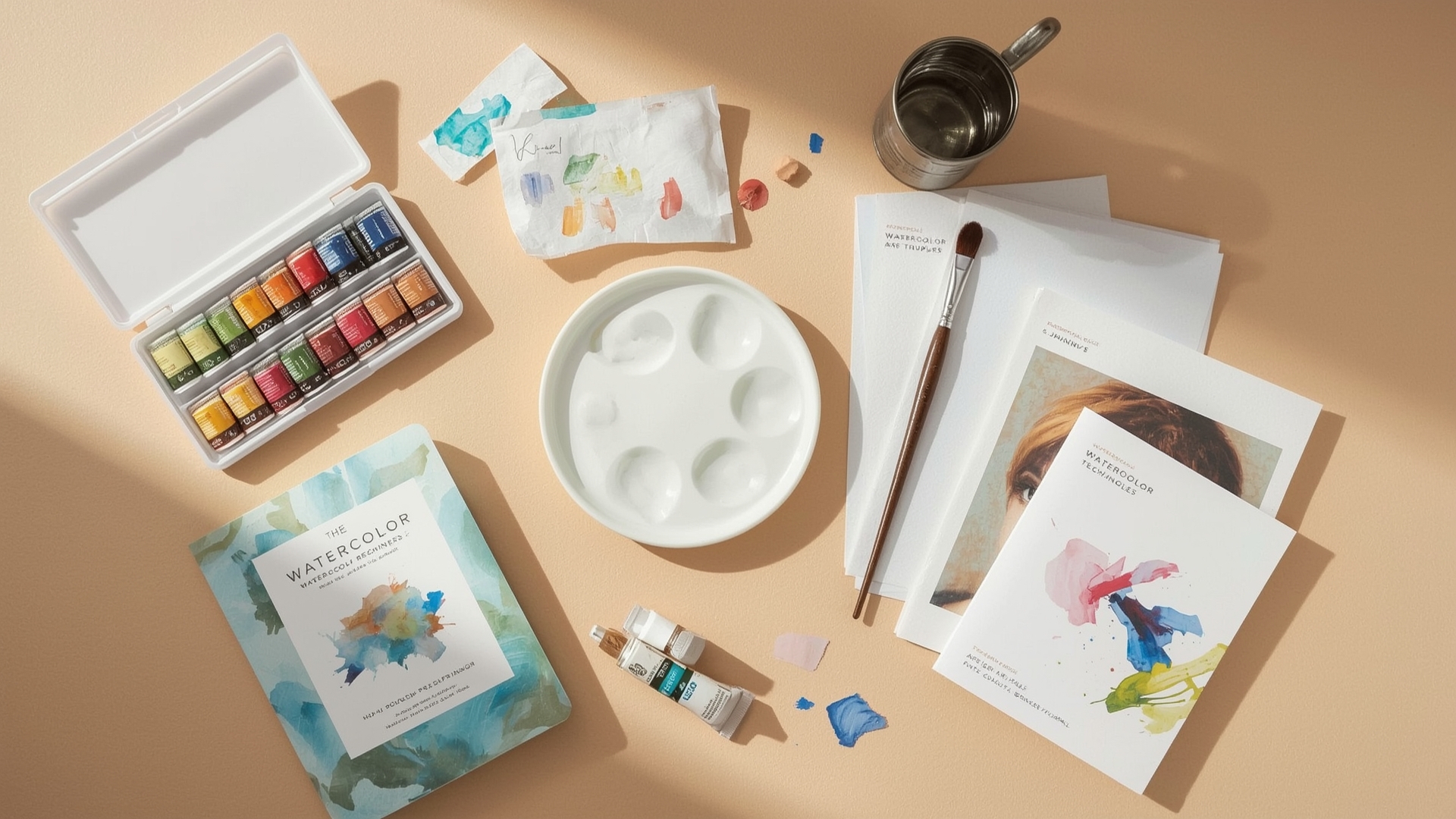

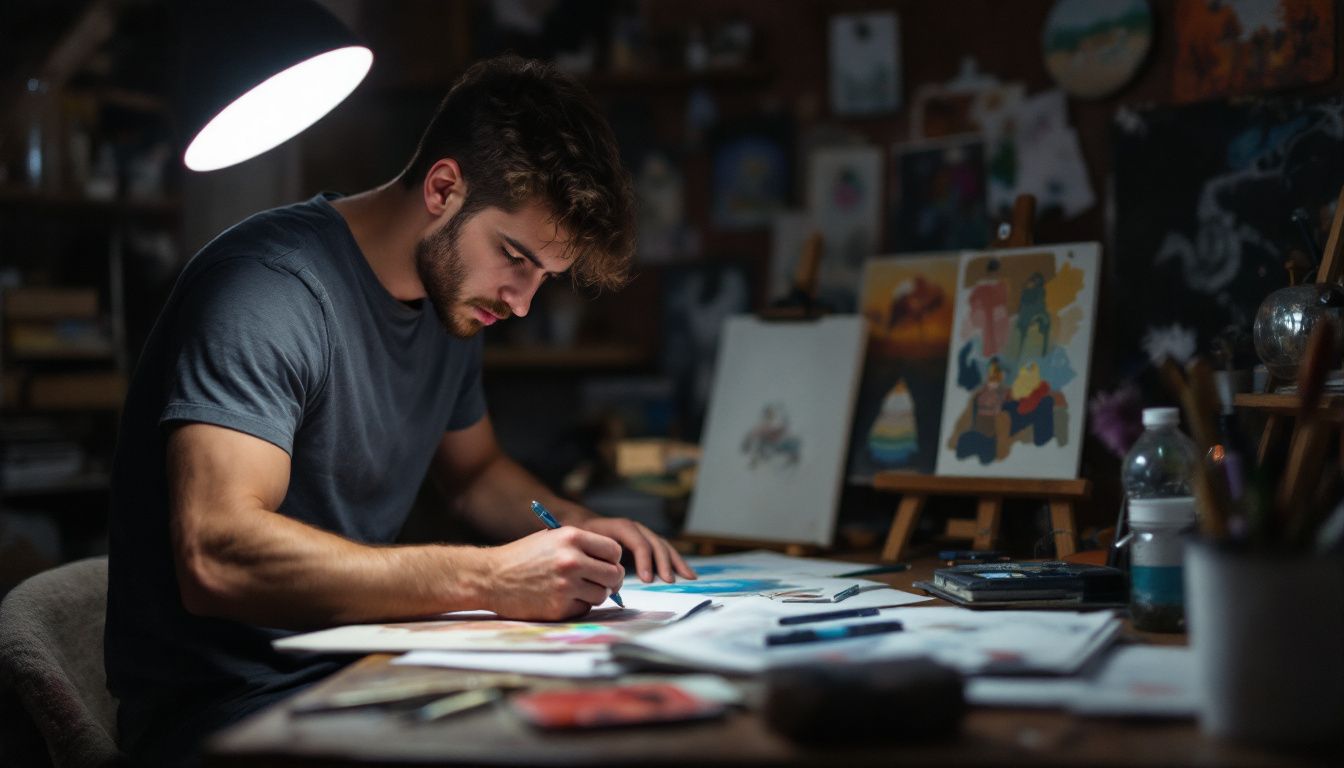
Leave a Reply